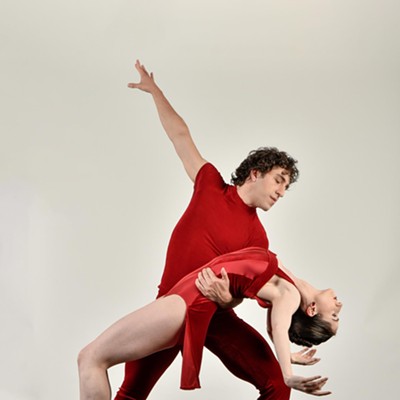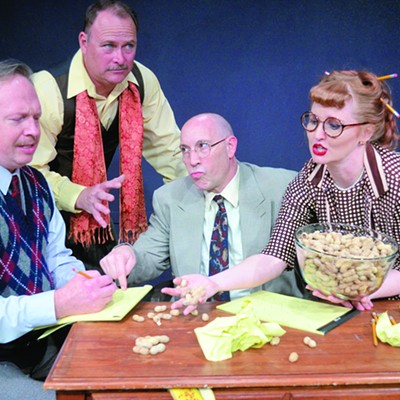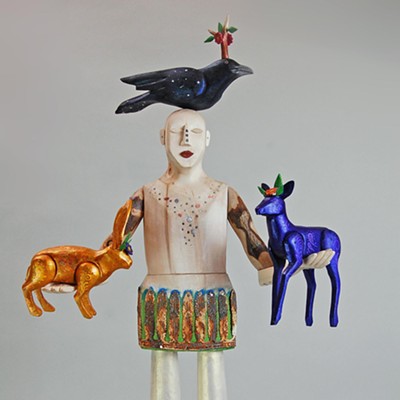The Hole Picture
Through the Pinhole: A Camera Obscura ExperienceThursday, Feb. 1, through Tuesday, Feb. 27
The Drawing Studio, 214 N. Fourth Ave.
620-0947
Nowadays, everybody has a digital camera. Or a picture phone. Or at least a Polaroid. And nobody thinks about how incredible photography is. I mean, really, how does that image come out of that box?!
Understanding pinhole camera art can explain a few things, as well as really make you appreciate the miracle that is a camera. You probably learned about this early version of photography at some point--in a college art class, maybe--and you've just forgotten. But this week at the Drawing Studio, you can find out all over again at a new exhibition featuring work produced with all kinds of pinhole cameras made from things like cardboard boxes, tin cans and traditional cameras with the lenses taken out.
"The fascinating thing about pinhole is that it's simple in concept," says Kathleen Velo, whose art will be featured in the show, "but you can become really sophisticated and complex with the images you make. I started doing it because I got really tired of hearing photographers talking about different lenses and cameras and technical equipment--when I think it's the image and the feeling and the idea that should be the main subject."
Besides pinhole camera art by about 17 different artists from all over the southern U.S., the main draw of this exhibition will be the gallery space itself--part of which will be transformed into a camera obscura. Visitors will be able to walk inside an 8-by-8-foot room and see projected on the wall everything going on outside on Fourth Avenue. Have you ever been inside a camera before? "It's absolutely magical," promises Velo.
An opening reception will take place from 6 to 9 p.m., Saturday, Feb. 3. But the show and camera obscura will be set up through the end of the month, so stop by anytime between noon and 5 p.m., Tuesday through Saturday. --A.M.
Give It a Whirl
Whirling Celebration6:30 to 9:30 p.m., Saturday, Feb. 3
Yoga Oasis, 2361 N. Campbell Ave.
299-2170
Remember when you were a kid and you liked to spin around and around really fast, over and over, until you fell down? It probably made you feel very dizzy. But did it make you feel close to God?
In case you didn't know, whirling is actually a legitimate religious practice started centuries ago by members of the Sufi order in Turkey--the whirling dervishes. The original whirlers were followers of Rumi, the famous 13th-century poet, jurist and theologian, and their main ceremony consisted of twirling around repeatedly to music as a remembrance of Allah and an enactment of man's ascent toward spiritual perfection.
"The whirling represents the rotation of the universe in the planets or other beings," explains Karen Poulson of Tucson's Institute for Applied Meditation. "Rotating from right to left around her heart, the dervish sends love to the universe by connecting Earth and the universe. In other words, it's a whirling or dancing meditation where the heavens are reflected in the Earth and the Earth turns into Heaven. Whirling is participatory, easy to do and fun."
If you've forgotten just how fun spinning around and around can be, you should go to the Institute for Applied Meditation's upcoming Whirling Celebration, which will include a lot of communal whirling as well as beautiful recitations of Rumi's poetry. Not only will the event be fun, but it will help your psyche, too--moving meditation exercises like whirling, asserts Poulson, help connect your heartbeat to your breath and brain waves. It has to do with Heart Rhythm Meditation--the institute's specialty--which "integrates physical, emotional and spiritual life to consciously create love, harmony and beauty."
The Whirling Celebration will be offered by donation. An RSVP is requested. --A.M.
Hawk Up Close
Harris' Hawk Demonstration11 a.m. to 1 p.m., every Wednesday
Tohono Chul Park, 7366 N. Paseo Del Norte
743-6455
When Sueño the Harris' hawk was just three weeks old, she had a nasty fall out of the family nest and broke two bones in her wing. She could easily have died. Luckily, one of her human neighbors found her and brought her to Kathie Schroeder, a local wildlife rehabilitator, who nursed her back to health. Though Sueño can't be released back into the wild, she has a great home with Schroeder, and after nearly four years together, the two have become quite attached.
"Harris' hawks are very social," Schroder declares, "and that's a rarity among birds of prey. No animal we get as a rehab case knows we're trying to help them, so that doesn't make it any easier, but since Sueño's such a social bird, she's just much more pleasant to care for."
In fact, Sueño is so social that Schroeder decided she'd be a perfect demonstration animal. She uses the bird for show-and-tell frequently, and starting this week, you can see Sueño live every Wednesday beneath the Children's Ramada at the Tohono Chul Park. It's a great chance to ask questions about Harris' hawks, which you've probably seen before from far away, perching on telephone poles or even nesting in that old, tall tree you have in your yard. They're easier to spot than other birds of prey because they live in family units throughout their lives. But you have to see Sueño up close to know how beautiful these creatures are. ("She seems to love being exhibited," says Schroeder, "especially for groups. And she also notices when people walk away and gets this look of disappointment.")
The demonstrations are free with park admission, and they're suitable for all ages. --A.M.
Beautiful Bugs
Project InsectSaturday, Feb. 3, through Sunday, April 22
Arizona-Sonora Desert Museum, 2021 N. Kinney Road
883-2702
While a lot of people don't think of insects as pretty, anyone who's looked at them up close has to admit their appeal. All those body segments, shiny exoskeletons and iridescent wings make them as worthy of being painted as any flower. But have you ever heard of an insect portraitist?
That's what you might call Jessa Huebing-Reitinger. Not only does she paint realistic, detailed illustrations of bugs, but she paints them as you would see them up close ... very close. Her wall-sized, oil-on-canvas portraits depict insects up to 200 times their actual size, just as they look through a microscope. And beginning this Saturday, you can watch Huebing-Reitinger as she engages in the artistic process five days a week at the Arizona-Sonora Desert Museum, where she's undertaken a special project. Over three months, she'll sketch and paint a humungous portrait of two of the most intriguing insects in the world: the tarantula hawk and its prey, the tarantula. These creatures were chosen because they're native to the Southwest and they have a dramatic relationship--specifically, the tarantula hawk paralyzes the tarantula and lays an egg on the still-live body, which later becomes food for the hatched larva. Do you find this gross? Huebing-Reitinger is determined to show you that even these insects can be art.
"(My painting) process becomes a discovery for people to see (insects) up close, for the first time," the artist said in a press release. "The art itself transcends what people typically think of when they see a small little bug crawling across the floor. At this scale, insects are seen differently and with beauty."
The exhibit is especially good for children, who can have insect "tattoos" painted on them by Huebing-Reitinger's husband while she does her thing on canvas. You can see her painting Wednesday through Sunday from 10 a.m. to 4 p.m.; it's free with museum admission. --A.M.







